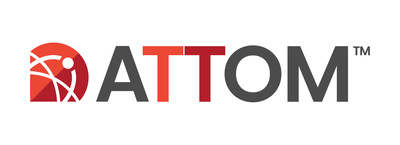HOME SALES PROFITS UP SLIGHTLY AS PRICES HIT RECORD HIGH
Typical home sale generated 50 percent profit in second quarter; Sellers still making less in raw dollars and profit margin than same time last year
IRVINE, Calif., July 24, 2025 /PRNewswire/ -- ATTOM, a leading curator of land, property data, and real estate analytics, today released its second quarter 2025 U.S. Home Sales Report, which shows that homeowners, on average, made a 50 percent profit selling single-family homes and condos during the second quarter of the year. That was a marginal increase over the 48.9 percent national median profit margin posted in the first quarter of 2025 but was down from a year ago when the typical home sale netted a 55.6 percent profit.
Profit margins for home sales have been trending downward since a recent peak of 64.3 percent in the spring of 2022. But the latest tick up is a sign that historically high home prices can continue to rise. The median national sales price in the second quarter of 2025 was $369,000, up 5.4 percent from the previous quarter and up 3.1 percent from a year ago.
Despite the continued growth in home prices, the typical home sale netted $123,000 in raw profit during the second quarter of 2025, which was down 5.6 percent from the $127,990 median profit posted in the second quarter of 2024.
"We saw historically high home prices last quarter but even so, we didn't see a big jump in seller profits," said Rob Barber, CEO for ATTOM. "That's a measure of the fact that home prices have been very high for a number of years now."
"While profit margins aren't going up significantly, they're still sitting at pretty good levels," he added. "The median home sale last quarter netted a 50 percent profit, whereas in the years right before the pandemic the typical seller was netting around 30 percent."
Profit margins down annually in more than three quarters of metro areas
Compared to the first quarter of the year, the profit margin for a typical home sale rose in 49.4 (77) of the 156 metropolitan statistical areas in ATTOM's analysis that had populations of at least 200,000 with at least 1,000 home sales in the second quarter. The profit margin is the percent difference between the median purchase price and median resale price for homes in an area. Year-over-year, however, the median profit margin was down in 78.8 (123) of the 156 metro areas.
The biggest annual decrease in median profit margins for the second quarter came in Ocala, FL (down from 97.6 percent to 61.8 percent); Knoxville, TN (down from 105.8 percent to 81 percent); Sarasota, FL (down from 70 percent to 47.8 percent); Punta Gorda, FL (down from 79.5 percent to 58.9 percent); and Naples, FL (down from 72.6 percent to 52.4 percent).
The largest annual increases in median profit margins were in Hilo, HI (up from 41.4 percent to 65.7 percent); Kalamazoo, MI (up from 59 percent to 69.3 percent); Flint, MI (up from 60.7 percent to 69.7 percent); Trenton, NJ (up from 73.8 percent to 81.4 percent); and Bridgeport, CT (up from 61.5 percent to 69 percent).
Among metro areas with populations over 1 million, the largest annual decrease in profit margins came in Las Vegas, NV (down from 60.6 percent to 46.9 percent); Jacksonville, FL (down from 57.8 percent to 44.4 percent); Tampa, FL (down from 73.7 percent to 60.8 percent); San Francisco, CA (down from 84.6 percent to 72.3 percent); and Columbus, OH (down from 68.6 percent to 56.6 percent).
And for those largest metro areas, the largest annual increases in profit margins were in Honolulu, HI (up from 37.2 percent to 42.7 percent); St. Louis, MO (up from 51.1 percent to 54.9 percent); Hartford, CT (up from 75.4 percent to 78.4 percent); Chicago, IL (up from 44.5 percent to 46.9 percent); and Buffalo, NY (up from 80.2 percent to 81.8 percent).
Home sales profit margins lag in big cities across Texas and the South.
More than half (55.8 percent) of the 156 metro markets in ATTOM's analysis saw profit margins that were equal to or higher than the national rate of 50 percent. That was down slightly from the previous quarter, when 59.6 percent of the markets posted typical profit margins over 50 percent.
Among the metro areas with at least 1 million residents, the highest typical profit margins were in San Jose, CA (101.2 percent); Buffalo, NY (81.8 percent); Seattle, WA (78.6 percent); Providence, RI (78.4 percent); and Hartford, CT (78.4 percent).
The large metro markets with the lowest typical profit margins were New Orleans, LA (20.5 percent); San Antonio, TX (24.7 percent); Houston, TX (33.2 percent); Austin, TX (33.9 percent); and Dallas, TX (34.2 percent).
Highest raw profits from sales seen in California, lowest in Southern cities.
The national median raw profit on a sale was $123,000 in the second quarter of 2025, down from $127,990 at the same time last year, and raw profits from home sales fell year-over-year in two thirds (103) of the 156 metro areas analyzed.
Among metro areas with populations over 1 million, the biggest annual decreases in raw profits came in Jacksonville, FL (down 18.5 percent); Austin, TX (down 16.9 percent); New Orleans, LA (down 16.7 percent); Las Vegas, NV (down 15.2 percent); and Tampa, FL (down 15 percent).
The large metro areas with the largest increases in raw profits were Honolulu, HI (up 16.9 percent); Chicago, IL (up 10.3 percent); St. Louis, MO (up 9.9 percent); Cincinnati, OH (up 9.1 percent); and Hartford, CT (up 8.3 percent).
In pure dollar figures the large metro areas with the highest typical profit on a home sale were San Jose, CA($830,000); San Francisco, CA($499,000); Los Angeles, CA($360,000); San Diego, CA($360,000); and Seattle, WA($330,050).
While the major metro markets with the smallest typical raw profits were New Orleans, LA($45,000); San Antonio, TX($61,015); Oklahoma City, OK($62,500); Birmingham, AL($65,000); and Louisville, KY($73,700).
Median home sale prices hit record high.
The national median home sale price hit a high of $369,000 in the second quarter of 2025, $19,000 more than the previous quarter and $10,000 above the previous high of $358,976 posted in the third quarter of 2024.
Year-over-year, the median sale price rose in 78.6 percent (125) of the 159 metro areas with sufficient data to analyze. Quarter-over-quarter, it grew in 90.6 percent (144) of the markets.
The metro areas with the largest year-over-year increases in typical home sales price were Hilo, HI (up 32.9 percent); Macon, GA (up 15.3 percent); Syracuse, NY (up 13.2 percent); Toledo, OH (up 12.8 percent); and Lubbock, TX (up 11.2 percent).
The markets with the largest year-over-year drops in typical home sales price were North Port-Sarasota, FL (down 12.1 percent); Cape Coral, FL (down 11 percent); Crestview, FL (down 8.6 percent); Punta Gorda, FL (down 8.6 percent); and Stockton, CA (down 7.4 percent).
Historical Median Home Sales Prices
Homeowners holding onto homes for record lengths of time before selling
The national average homeownership tenure—the amount of time between an owner buying and selling a home—rose to 8.18 years for homes sold in the second quarter of 2025, the longest it's been in at least 25 years and up 4.3 percent compared to the second quarter of 2024.
The average homeownership tenure increased year-over-year in 80.7 (92) of the 114 metro markets with sufficient data to analyze.
The metro areas with the longest homeownership tenures for homes sold in the second quarter of 2025 were Barnstable, MA (14.26 years); Santa Cruz, CA (13.23 years); New Haven, CT (13.15 years); Springfield, MA (13 years); and Hartford, CT (12.82 years).
The metro markets with the shortest ownership tenures for homes sold in the second quarter were Oklahoma City, OK (6.81 years); Provo, UT (6.96 years); Panama City, FL (7.16 years); Kansas City, MO (7.17 years); and San Antonio, TX (7.20 years).
Average U.S. Homeownership Tenure
Lender-owned sales drop back down.
Homes sold by banks or other lenders following foreclosures accounted for 1.3 percent of all sales nationwide in the second quarter of 2025, down from 1.5 percent in the previous quarter and 1.4 percent at the same time last year.
Among metro areas with sufficient data to analyze, the markets with the highest proportion of lender-owned sales were Macon, GA (5.5 percent); Shreveport, LA (4.9 percent); Flint, MI (4.6 percent); Honolulu, HI (4.1 percent); and Baton Rouge, LA (4 percent).
The markets with the smallest share of lender-owned sales were Phoenix, AZ (0.4 percent); Denver, CO (0.4 percent); Seattle, WA (0.5 percent); Los Angeles, CA (0.5 percent); and Columbus, OH (0.6 percent).
Share of all-cash sales dips nationwide
All-cash transactions accounted for 38.9 percent of home sales nationwide in the second quarter of 2025, down from 42.1 percent the previous quarter and down from 39.1 percent the same time last year.
Among metro areas with sufficient data to analyze, the markets with the largest proportions of all-cash sales were Myrtle Beach, SC (70.6 percent); Claremont, NH (69 percent); Utica, NY (66.1 percent); Hilo, HI (65.9 percent); and Honolulu, HI (65.6 percent).
The metro areas with the smallest proportions of all-cash sales were Washington, D.C. (22.6 percent); Kennewick, WA (22.9 percent); Vallejo, CA (23 percent); Jacksonville, NC (23.4 percent); and Charleston, WV (23.9 percent).
Institutional investor purchases down year-over-year
The proportion of homes sold to institutional investors nationwide in the second quarter of 2025 dropped slightly to 5.7 percent, from 5.8 percent the previous quarter. But it was down more significantly compared to the same time last year, when 6.5 percent of home sales involved institutional investors.
The metro areas with the highest proportion of sales to institutional investors were Memphis, TN (14.5 percent); Huntsville, AL (12.5 percent); Oklahoma City, OK (10.2 percent); Columbus, GA (10.2 percent); Clarksville, TN (10.2 percent).
FHA sales hold steady
Nationwide during the second quarter of 2025, about 8.3 percent of all home purchases were made using Federal Housing Administration (FHA) loans. That was up slightly from 8.2 percent in the previous quarter and from 8.1 percent the same time last year.
The metro areas with the highest proportion of sales involving FHA loans were Merced, CA (24.6 percent); Bakersfield, CA (24 percent); Visalia, CA (22.3 percent); Hagerstown, MD (21.4 percent); and Lakeland, FL (20.9 percent).
Report methodology
The ATTOM U.S. Home Sales Report provides percentages of REO sales and all sales that are sold to institutional investors and cash buyers, at the state and metropolitan statistical area. Data is also available at the county and zip code level, upon request. The data is derived from recorded sales deeds, foreclosure filings and loan data. Statistics for previous quarters are revised when each new report is issued as more deed data becomes available.
Definitions
All-cash purchase: sale where no loan is recorded at the time of sale and where ATTOM has coverage of loan data.
Homeownership tenure: for a given market and given quarter, the average time between the most recent sale date and the previous sale date, expressed in years.
Home seller price gains: the difference between the median sales price of homes in a given market in a given quarter and the median sales price of the previous sale of those same homes, expressed both in a dollar amount and as a percentage of the previous median sales price.
Institutional investor purchases: residential property sales to non-lending entities that purchased at least 10 properties in a calendar year.
REO sale: a sale of a property that occurs while the property is actively bank owned (REO).
About ATTOM
ATTOM powers innovation across industries with premium property data and analytics covering 158 million U.S. properties—99% of the population. Our multi-sourced real estate data includes property tax, deed, mortgage, foreclosure, environmental risk, natural hazard, neighborhood and geospatial boundary information, all validated through a rigorous 20-step process and linked by a unique ATTOM ID.
From flexible delivery solutions—such as Property Data APIs, Bulk File Licenses, Cloud Delivery, Real Estate Market Trends—to AI-Ready datasets, ATTOM fuels smarter decision-making across industries including real estate, mortgage, insurance, government, and more.
Media Contact:
Megan Hunt
megan.hunt@attomdata.com
Data and Report Licensing:
datareports@attomdata.com
![]() View original content to download multimedia:https://www.prnewswire.com/news-releases/home-sales-profits-up-slightly-as-prices-hit-record-high-302512875.html
View original content to download multimedia:https://www.prnewswire.com/news-releases/home-sales-profits-up-slightly-as-prices-hit-record-high-302512875.html
SOURCE ATTOM


